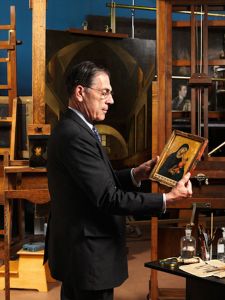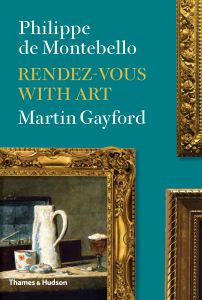A Quiet Passion for Art

Philippe de Montebello holding Duccio di Buoninsegna’s Madonna and Child (c.1290-1300). The Metropolitan Museum of Art.
Like a proud father gazing admiringly at the latest addition to the family, Philippe de Montebello holds the small panel painting of the Madonna and Child at just the right angle to benefit the camera. As then director of The Metropolitan Museum of Art, he might have arranged for the photo shoot on the occasion of his visit to the conservation laboratory soon after the new arrival–the museum’s first Duccio di Buoninsegna–was brought home in 2004.
When the painting appeared on the market, de Montebello had to consider whether it was worth the $45 million he knew it would cost. Of the many factors that went into his decision, the physical encounter with the actual object seems to have been a deciding one, assisted by what he describes to co-author Martin Gayford in Rendez-vous with Art as “the irrepressible need…to have taken possession of the object of desire.”
For de Montebello, this direct engagement with artworks forms the core of his personal enjoyment of them. It motivated him some fifty years ago to seek employment at The Met, less out of interest in the museum itself than for its contents. He wanted to “enjoy their physicality, hold them, move them about, and above all share [his] passion with…many others.” Not surprising then that this photograph became the frontispiece of Rendez-vous with Art, a book in which de Montebello–now director emeritus of that encyclopedic museum in New York City, in collaboration with his sidekick–art critic and writer–Gayford, continues to share his enthusiasm with others.
The seed for the book was planted when the publishers, Thames & Hudson, approached de Montebello about writing something for them and he demurred. They turned for help to Gayford, one of their writers, whose skill at entering into dialogs with artists produced such winners as Man with the Blue Scarf, his story of posing for Lucien Freud. This time, however, his subject was to be an art connoisseur, and first they had to meet.
The initial conversation happened over lunch in Paris, where Gayford caught up with de Montebello, abroad at the time. The chemistry was right and by the end of their amiable chat they agreed to develop something together. Several months later, when life brought Gayford to New York, the two met again and tossed around some ideas, among them the question, “What is a museum?” Next stop would be The Met and de Montebello’s choice for the greatest work of art in the world.
Whoever chose the title–Rendez-vous with Art–opted for the French spelling of the first word with its meaning of appointment but also perhaps because of its etymology. It derives from the imperative form of se rendre, to present oneself, and translates: Present yourself! Rendezvous (one word, no hyphen) in English carries the additional connotation of assignation or tryst, a meeting between two lovers.
In the book, art is the object of desire that commands de Montebello and Gayford to present themselves. They obey its directive over the course of many months whenever the peripatetic museum director alights in a city accessible in time and space to the art critic, whose base of operations is England. For the greater good, de Montebello engages in his least favorite activity, talking about artwork he loves while immersed in its magic. Gayford holds a microphone under his nose, capturing the precious words that they will later integrate into an ongoing narrative that frames one man’s emotional response to art within each object’s historical context and current museum placement.
![Fragment of a Queen's Face, New Kingdom, 18th dynasty, reign of Akhenaten. From Middle Egypt, probably el-Amarna/Akhetaten (c. 1353–1336 BCE, yellow jasper, 5⅛ x 4⅞ x 4⅞ in [13 x 12.5 x 12.5 cm]). The Metropolitan Museum of Art. Photograph by Bruce White. © The Metropolitan Museum of Art.](http://www.deborahfeller.com/news-and-views/wp-content/uploads/2014/12/Fragment-of-Egyptian-Queens-Face-240x300.jpg)
Fragment of a Queen’s Face (c. 1353–1336 BCE, yellow jasper, 5⅛ x 4⅞ x 4⅞ in [13 x 12.5 x 12.5 cm]). Middle Egypt. The Metropolitan Museum of Art. Photograph by Bruce White. © The Metropolitan Museum of Art.
This first visit to a beloved object establishes the format of the book: a dialog in front of a work of art–each part indicated in print by the actor’s initials (as in a script) in different typefaces–and a third voice (mostly Gayford’s, in yet another font) that binds together this collage of conversations by setting the stage for each day’s events, providing additional art historical information and occasionally ruminating on the nature of museums.
Connecting objects like the yellow jasper lips with works they will later visit, the writers note that all art displayed in museums is fragmentary and forever incomplete, wrenched as it was from some other context. Constantly changed by the effects of time, the company it keeps in museum galleries and the varying perspectives of its viewers, art–once it leaves the hands of its maker–can never be known again in its original form. Underscoring the inevitability of this, in the penultimate chapter the reader learns that the director thought to call the current book The Art Museum: An Imperfect Construct.
Considering all the knowledge, ideas and opinions de Montebello accumulated during his time in the museum world, and that those interests inform many of his exchanges with Gayford, that other title deserves a book of its own. In the aptly named Rendez-vous with Art, the more compelling story is his love affair with art and the solace it affords him.
![Fra Angelico, The Annunciation (1425-1428, gold and tempera on wooden panel, 76⅜ x 76⅜ in [194 x 194 cm]). Image courtesy of Museo del Prado, Madrid.](http://www.deborahfeller.com/news-and-views/wp-content/uploads/2014/12/Fra-Angeloco-The-Anunciation-300x300.jpg)
Fra Angelico, The Annunciation (1425-1428, gold and tempera on wooden panel, 76⅜ x 76⅜ in [194 x 194 cm]). Image courtesy of Museo del Prado, Madrid.
Quieter viewing circumstances greeted them on their visit to the Boijmans van Beuningen in Rotterdam, a side trip occasioned when de Montebello’s travels brought them to Amsterdam during renovations at the Rijksmuseum, where Rembrandt’s Night Watch might have been one of their choices. Instead, they found themselves in front of another Dutchman’s paintings.
![Pieter Jansz. Saenredam, The Mariaplaats with Mariakerk in Utrecht (1662, oil on panel, 45⅛ x 54⅞ in [109.5 x 139.5 cm]). Museum Boijmans van Beuningen, Rotterdam.](http://www.deborahfeller.com/news-and-views/wp-content/uploads/2014/12/Saenredam-Mariaplaats-w-Mariakerk-300x235.jpg)
Pieter Jansz. Saenredam, The Mariaplaats with Mariakerk in Utrecht (1662, oil on panel, 45⅛ x 54⅞ in [109.5 x 139.5 cm]). Museum Boijmans van Beuningen, Rotterdam.
![Pieter Jansz. Saenredam, The Interior of St. Janskerk at Utrecht (c. 1650, oil on panel, 26 x 33½ in [66 x 85]). Museum Boijmans van Beuningen, Rotterdam.](http://www.deborahfeller.com/news-and-views/wp-content/uploads/2014/12/Saenredam-Interior-of-St-Janskerk-300x229.jpg)
Pieter Jansz. Saenredam, The Interior of St. Janskerk at Utrecht (c. 1650, oil on panel, 26 x 33½ in [66 x 85]). Museum Boijmans van Beuningen, Rotterdam.
![Pieter Bruegel the Elder, The Tower of Babel (c. 1565, oil on panel, 23⅝ x 29⅜ in [59.9 x 74.6 cm]). Image courtesy of Museum Boijmans van Beuningen, Rotterdam.](http://www.deborahfeller.com/news-and-views/wp-content/uploads/2014/12/Bruegel-Tower-of-Babel-300x240.jpg)
Pieter Bruegel the Elder, The Tower of Babel (c. 1565, oil on panel, 23⅝ x 29⅜ in [59.9 x 74.6 cm]). Image courtesy of Museum Boijmans van Beuningen, Rotterdam.
He’s not alone. Research has found that regardless of whether they’ve ever been to one, people prefer pictures of the savanna, a landscape with slightly elevated areas that look out over large, grassy fields interrupted by few trees. From such overlooks, Pleistocene humans could quickly detect any large animals whose presence might mean for them danger or dinner, depending on who spotted whom first.1
![The Dying Lioness from Nineveh, Assyrian period. From the North Palace of Ashurbanipal (660 BCE, alabaster mural relief, 6½ x 114/5 in [16.5 x 30 cm]). British Museum, London.](http://www.deborahfeller.com/news-and-views/wp-content/uploads/2014/12/Ashurbanipal-dying-lioness-300x225.jpg)
The Dying Lioness from Nineveh, Assyrian period. From the North Palace of Ashurbanipal (660 BCE, alabaster mural relief, 6½ x 114/5 in [16.5 x 30 cm]). British Museum, London.
Once again it is the skill of the artist that most impresses de Montebello. Although the lions are not depicted naturalistically, they have been “observed with a piercingly accurate as well as sympathetic eye…their suffering…rendered with incredible specificity as to the condition of each.”
![Pieter Brueghel the Elder, The Triumph of Death (c. 1562, oil on panel, 46 x 634/5 in [117 x 162 cm]). Museo del Prado, Madrid.](http://www.deborahfeller.com/news-and-views/wp-content/uploads/2014/12/Breugel-The-Triumph-of-Death-300x212.jpg)
Pieter Brueghel the Elder, The Triumph of Death (c. 1562, oil on panel, 46 x 634/5 in [117 x 162 cm]). Museo del Prado, Madrid.
Indeed, though many of the visited masterpieces elicit extensive reflections on that imperfect construct, the art museum, the gold to be mined in Rendez-vous with Art is de Montebello’s unabashedly personal responses to his long-standing favorites. When he compares museum goers who have knowledge of art history (a group to which he obviously belongs) to those more plentiful ones with none, he reminds the reader that “most people react and ‘feel’–or not–in front of works of art.”
![Albrecht Dürer, Adam and Eve (1507, oil on two panels, each 82 x 32 in [209 x 81 cm]). Image courtesy Museo del Prado, Madrid.](http://www.deborahfeller.com/news-and-views/wp-content/uploads/2014/12/Durer-Adam-and-Eve-229x300.jpg)
Albrecht Dürer, Adam and Eve (1507, oil on two panels, each 82 x 32 in [209 x 81 cm]). Image courtesy Museo del Prado, Madrid.
Before good fortune landed him at The Metropolitan Museum of Art, Philippe de Montebello was a young man with a craving to spend as much time as possible around works of art. Decades later, the former student at the Institute of Fine Arts now holds a professorship there, eminently qualified to discourse at length on all things art historical. Yet he still claims his right to wander among the objects of his desire like everyone else, responding not as an academic but as the passionate art lover he has always been.
________________________
1 Anjon Chatterjee, The Aesthetic Brain (New York City: Oxford University Press, 2014), 48-49.
Special thanks to Martin Gayford and Philippe de Montebello for taking time out of their busy schedules to discuss the book.
Rendez-vous with Art
by Philippe de Montebello
& Martin Gayford
Published by Thames & Hudson
2014


